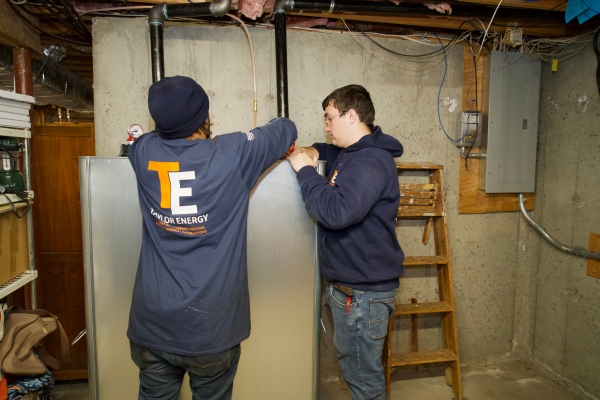Contents
- Understanding Double-Wall Heating Oil Tanks
- Functionality of a Double-Wall Heating Oil Storage Tank
- Advantages of Using a Double-Wall Fuel Oil Tank
- Installing a Double-Wall Home Heating Oil Tank: A Step-by-Step Guide
- Inspection and Monitoring Practices for Double-Wall Oil Tanks
- Double-Wall Heating Oil Tank: FAQs
- Conclusion
- Contact Taylor Energy for Reliable Heating Oil Delivery
Many homes across the eastern United States rely on heating oil for warmth. This fuel is held in a tank on-site before being transported to the home’s furnace or boiler to generate heat. For homeowners contemplating a replacement of their existing oil tank, a double-wall heating oil tank presents a valuable option. This article by Taylor Energy will explore the nature of double-wall oil tanks, highlight their advantages, and explain the reasons a homeowner might opt for this type of fuel storage tank.
Understanding Double-Wall Heating Oil Tanks

A double-wall heating oil tank features an inner tank encased by an outer tank. The gap between these two tanks is known as the interstitial space. This space acts as a protective barrier, effectively preventing any leaks or spills from the inner tank from contaminating the environment.
The interstitial space is securely sealed and equipped with alarms and sensors to alert the owner of leaks. Should a leak occur, this space contains the leakage, ensuring it does not escape into the environment.
Additionally, double-wall tanks are fitted with a component known as a “spill bucket.” Positioned within the interstitial space, this small container captures any leaks or spills, offering an extra safeguard against environmental contamination.
Schedule Your Complimentary Consultation: Thinking about upgrading to a double-wall heating oil tank? Get in touch with Taylor Energy today for a no-cost consultation to learn how we can boost the efficiency and safety of your home heating system.
Functionality of a Double-Wall Heating Oil Storage Tank
The inner tank of a double-wall heating oil tank holds the fuel, while the outer tank serves as a secondary containment barrier. In the event of a leak or spill from the inner tank, the interstitial space between the two tanks captures the fuel. This design prevents any fuel from escaping into the environment and causing harm.
Advantages of Using a Double-Wall Fuel Oil Tank

Double-wall heating oil tanks provide numerous advantages compared to single-wall tanks. The foremost benefit is the enhanced protection against leaks and spills. The secondary containment barrier in a double-wall tank offers an extra layer of security, which is not available with single-wall tanks.
An additional advantage of double-wall heating oil tanks is their enhanced durability and longevity. The outer tank of a double-wall system can be constructed from high-density polyethylene (HDPE), a robust, UV-resistant material designed to endure severe weather conditions. This resilience makes double-wall tanks an excellent choice for outdoor installations.
Installing a Double-Wall Home Heating Oil Tank: A Step-by-Step Guide

- Selecting the Ideal Location: It is crucial to select the optimal location for your double-wall heating oil tank. It should be easily accessible for fuel delivery and maintenance while adhering to local safety regulations. In addition, choose a site that is protected from environmental risks such as flooding or proximity to overhead power lines.
- Preparing the Site: Site preparation requires leveling the area where the tank will be placed. You might also need to construct a concrete pad or install stable pavers to provide a solid foundation. This base must be capable of supporting the tank’s weight and preventing any movement over time.
- Placing the Oil Tank: Once the site is prepared, the tank is precisely positioned to ensure it remains stable and level, which is essential for optimal operation. Professional installers will then securely connect the tank to your home’s heating system, complying with all applicable safety standards to ensure the setup is sealed and impervious to leaks.
- Conducting Safety Checks and Completing Installation: Technicians carry out a thorough series of safety checks following the installation. This process includes verifying that there are no leaks in the interstitial space and confirming the functionality of all alarms and sensors. These steps ensure that the tank is safe and efficient, ready to provide reliable heating for your home.
Inspection and Monitoring Practices for Double-Wall Oil Tanks

It is crucial to conduct regular inspections and maintain diligent monitoring to guarantee the long-term reliability and safety of double-wall heating oil tanks. Below is an outline of the key practices:
Regular Inspections of Double-Wall Fuel Oil Tanks
Conducting routine professional inspections is essential for maintaining the structural integrity of the inner and outer tanks of a double-wall heating oil system. These assessments are critical for the early detection of potential issues, helping to prevent small problems from developing into significant failures.
Seek Professional Guidance on Heating Oil Tanks: Uncertain about the best option for your home? Arrange a complimentary consultation with our experts at Taylor Energy to explore the benefits of transitioning to a double-wall heating oil tank. Contact us today!
Advanced Oil Tank Monitoring Systems
Contemporary double-wall tanks typically come with sophisticated monitoring systems that continuously scrutinize the interstitial space between the inner and outer tanks. These systems are finely tuned to detect minor anomalies or the presence of oil, signaling potential leaks.
Home Heating Oil Tank Alarm Systems
Alarm systems are built into the design of the tanks and provide instant notifications in case of leaks or structural issues. These alarms are vital for enabling a quick response, effectively minimizing possible environmental and safety risks.
Compliance Checks for Heating Oil Tanks
Consistent inspections and monitoring go beyond preserving the tank’s integrity; they are crucial for adhering to local and state regulations. These compliance checks help maintain environmental safety standards and prevent potential legal complications. By following these guidelines, homeowners can greatly prolong the lifespan of their heating oil tanks, ensuring they function safely and efficiently.
Explore the Advantages of Double-Wall Heating Oil Tanks: Interested in understanding the benefits of double-wall heating oil tanks? Reach out for a no-cost consultation to discover more about their sturdy construction and exceptional leak-prevention capabilities for your home. Contact Taylor Energy today!
Double-Wall Heating Oil Tank: FAQs

Are Double-Wall Heating Oil Tanks More Costly Than Single-Wall Tanks?
Yes, double-wall heating oil tanks generally come at a higher price point compared to single-wall tanks. Despite this, the enhanced leak and spill protection, coupled with greater durability, often justifies the additional expense over time. Double-wall tanks demand a higher investment for these significant advantages:
Firstly, the construction materials for double-wall tanks contribute to their higher cost. The inner tank utilizes the same materials as single-wall tanks. Still, the outer tank is crafted from high-density polyethylene (HDPE), a pricier material than the steel or regular plastic used in single-wall versions.
Secondly, the manufacturing process for double-wall tanks is inherently more intricate. The inner and outer tanks are built separately and subsequently assembled, which increases the overall expense. Moreover, the interstitial space between the two tanks must be meticulously sealed and tested for leaks, further elevating production costs.
Thirdly, the installation process for double-wall tanks is more involved compared to single-wall tanks. Ensuring the tanks are properly leveled and monitoring the interstitial space for leaks contribute to higher installation costs.
Lastly, double-wall tanks are designed for enhanced durability and longevity, positioning them as a long-term investment. While they are more costly upfront, they can lead to savings over time by minimizing the need for expensive repairs and replacements.
Is It Possible to Install a Double-Wall Heating Oil Tank Inside My Home?
Absolutely, you can install double-wall heating oil tanks indoors. However, it’s essential to place the tank in a well-ventilated space to prevent any hazardous buildup of fumes and ensure safe indoor use.
Adhering to the manufacturer’s guidelines and local building codes is crucial when setting up a double-wall heating oil tank indoors. It’s also essential to ensure proper ventilation, like installing a vent pipe to expel any fumes outdoors to prevent dangerous fume accumulation within the home.
Additionally, when installing a double-wall heating oil tank indoors, it’s prudent to implement extra safety precautions, such as placing a spill containment tray underneath to catch any potential leaks or spills.
It is highly recommended that you consult a professional experienced in heating oil tank installations to secure the best advice and ensure adherence to safety and regulatory standards.
Discover the Advantages of Double-Wall Heating Oil Tanks: Interested in learning how double-wall heating oil tanks can enhance your home’s safety and efficiency? Book a complimentary consultation with Taylor Energy today to explore their superior protection and long-lasting durability. Contact us now!
Is It Mandatory to Use Double-Wall Heating Oil Tanks?
The rules governing double-wall heating oil tanks differ across states and local areas. While not universally mandated by law, numerous states enforce regulations requiring secondary containment for fuel storage tanks.
In certain regions, regulations stipulate that all new tanks must be double-wall, whereas other areas may only require this for tanks that are being replaced. Furthermore, some rules mandate that existing single-wall tanks be upgraded with secondary containment measures, which could involve installing a double-wall tank or adding a secondary containment tray.
It’s advisable to consult with your local government agency or a professional who is well-versed in the regulations specific to the area where the tank will be installed. This approach will help ensure that your tank complies with legal requirements and that your fuel storage remains safe and secure.
Conclusion
A double-wall heating oil tank is an advanced fuel storage option that delivers enhanced protection against leaks and spills. It boasts increased durability and provides secondary containment, making it an excellent choice for homeowners looking to replace their existing oil tank. Although double-wall tanks are generally more costly than single-wall versions, the superior protection, extended lifespan, and overall peace of mind they offer often justify the investment over time.
Contact Taylor Energy for Reliable Heating Oil Delivery
Taylor Energy is dedicated to keeping homes and businesses in Northern Connecticut warm with dependable heating oil delivery. We ensure fast, efficient service, competitive pricing, and a focus on your comfort.
We offer flexible delivery plans and financing options tailored to meet your needs. Our personalized service ensures your home stays warm and comfortable all winter long.
In addition to heating oil, Taylor Energy provides full HVAC services, including installation, maintenance, and emergency repairs—your one-stop shop for home comfort.
Trust Taylor Energy for reliable service and customer satisfaction. Contact us today to get started!
Every delivery from Taylor Energy comes with our steadfast guarantee. Our service isn’t just about delivering oil; it’s about ensuring your home remains warm and your peace of mind is intact. When it’s time to refill, don’t settle for less. Ensure seamless, hassle-free service with Taylor Energy. Schedule your next delivery with us today and experience the Taylor Energy difference. For a free consultation or to get an estimate, reach out to Taylor Energy now.
You can click here to contact us now or call us at (860) 623-3308 to find out more! Click the link to view our service area.

Related Articles:
